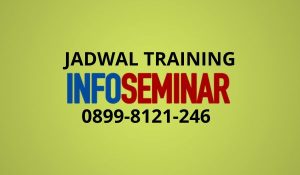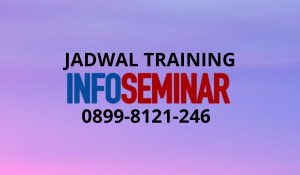Configuring and Administering Windows 7 – CONFIRM RUNNING
Schedule
28 Mei – 1 Juni 2012
Location
Chase Plaza Building Lt. 9
Jl. Jend. Sudirman kav. 21
About this Course
This five-day instructor-led course provides students with the knowledge and skills to configure and administer Microsoft Windows 7 as a standalone installation or in a corporate environment as a part of a Windows Active Directory domain. It can also be used to prepare for exam 70-680 TS: Windows 7, Configuring.
The contents of the course provide students with the ability to create and deploy images, configure hardware and software, configure networking and backup and restore system information. The course also provides a complete set of exercises on installing and configuring DirectAccess in the classroom.
Audience Profile
This course is intended for novice and experienced Network Administrators, Desktop Support Technicians or other IT professionals who have a need to install, configure, and administer Microsoft Windows 7. This course can also serve as training preparation for the Windows 7 certification exams.
At Course Completion
After completing this course, students will be able to:
- Describe and choose the various versions of Windows 7.
- Perform a clean install of Windows 7.
- Create an image for deployment.
- Configure hardware devices.
- Configure software for compatibility.
- Configure networking including sharing resources.
- Configure DirectAccess for the network.
- Monitor and configure system performance.
- Perform backups and configure system restore.
Before attending this course, students must have:
- Experience with previous versions of Windows operating systems such as Windows XP or Windows Vista.
- Some knowledge of Windows Server operating systems and Active Directory concepts.
In addition, students are expected to understand:
- Networking with TCP/IP including IPv4 and some IPv6 knowledge.
- A general understanding of user accounts and authentication.
Course Outline
Module 1: Installing Windows 7
This module explains the various editions of Windows 7 and some of the core features of the operating system. Students will learn the hardware requirements and upgrade paths to Windows 7. The module will also show students how to prepare an image of the operating system for deployment.
Lessons
- Introduction to Windows 7
- Installing Windows 7 Using Image-Based Installation
- Migrating User Settings
Lab : Configure a Reference Computer for Imaging
- Configure the Reference Computer
- Clean the image with sysprep
- Prepare the image for deployment
Lab : Capture an Image Using ImageX
- Capture the image and copy to a network share
Lab : Deploy a Windows 7 Image
- Prepare a virtual machine to receive the image
- Prepare the disk and image the new computer
- Configure the newly installed OS image
Lab : Migrate User Settings
- Migrate settings to a server
- Transfer user settings to new computer
After completing this module, students will be able to:
- Describe the various editions of Windows 7
- Configure and deploy a Windows 7 image
- Learn to use ImageX for image creation and deployment
- Use Diskpart to prepare disk partitions to receive a new operating system
- Migrate user settings
Module 2: Configure Hardware and Software
This module explains how to install and configure hardware devices on Windows 7. Users will learn how to add hardware devices, install and update drivers and configure options. It also teaches the student how to configure application compatibility and how to lock down a Windows 7 computer using AppLocker.
Lessons
- Configure Devices
- Configure Application Compatibility
Lab : Install and Configure Devices
- Add a printer
- Configure printer properties
- Configure properties for COM1
- View device driver details
- Configure Device Manager
Lab : Configure Application Compatibility
- Configure application compatibility settings
- Configure the Application Compatibility Toolkit
Lab : Configure Application Restrictions
- Configure application execution permissions
- Configure network zone rules for applications
- Restrict application execution using AppLocker
Lab : Configure Internet Explorer
- Configure the home page and browser history settings
- Configure security settings in Internet Explorer
- Configure content ratings in Internet Explorer
- Manage Internet Explorer Add-ons
- Configure Internet Explorer using Group Policy
After completing this module, students will be able to:
- Install and configure hardware devices
- View properties on and driver information for hardware
- Configure application compatibility setting
- Configure application restrictions
- Configure Internet Explorer
Module 3: Configure the Network
This module explains how to configure the networking aspects of Windows 7. Students will be introduced to configuration of general network settings including TCP/IP network configuration using IPv4 and IPv6 settings. They will also learn about wireless network configuration. Students will also learn how to share resources across the network, configure the Windows Firewall for security, configure remote management using Remote Desktop and Remote Assistance, and troubleshoot network connectivity issues.
Lessons
- Configure General Network Settings
- Managing Wireless Networks
- Sharing Resources
- Configure TCP/IP
- Troubleshooting Network Connectivity
- Configure Windows Firewall
- Configure Remote Management
Lab : Configure Network Discovery
- Turn on and configure Network Discovery
- Create a network map
Lab : Configure TCP/IP Settings
- Configure Static IPv4 Settings
- Configure IPv4 for Dynamic IP Addressing
- Configure IPv6 Addressing
- Using PING
- Using ipconfig
- Using tracert
- Using nslookup
Lab : Configure Windows Firewall
- Configure Windows Firewall Settings for the Private Network
- Configure Windows Firewall for the Public Network
- Configure Additional Programs Access
- Configure Advanced Firewall Settings
- Configure Inbound Rules
- Configure Outbound Rules
Lab : Configure Remote Management
- Configure Remote Desktop
- Configure Remote Assistance
- Secure Remote Assistance with Group Policy
After completing this module, students will be able to:
- Configure networking on Windows 7 including network discovery
- Configure TCP/IP settings using IPV4 and IPv6
- Configure the Windows Firewall
- Configure and use Remote Desktop and Remote Assistance
Module 4: Sharing and Securing Resources
This module explains how to implement sharing of resources on the network with Windows 7 computers. Topics covered will introduce the student to share permissions and NTFS permissions. Students will also learn how configure and implement a HomeGroup using Windows 7 computers.
Once the student understands how to share resources and make them available on the network, they will be introduced to securing the computer through the use of the User Account Control (UAC) features of Windows 7. They will also learn how to work with authentication and authorization to the computer and the use of digital certificates. Finally, the students will learn about the BranchCache feature of Windows 7 and Windows Server 2008 R2.
Lessons
- Configure Shared Resources
- Configuring HomeGroup Settings
- Configure User Account Control (UAC)
- Configure Authentication and Authorization
- Configure BranchCache
Lab : Configure Shared Resources
- Configure Shared Folders in Computer Management
- Configure Shares Using Windows Explorer
- Configure properties for COM1
- Share a printer
Lab : Configure HomeGroup Settings
Lab : Configure User Account Control (UAC)
- Configure UAC Prompt Behaviors
- Configure UAC Group Policy Settings
- Configure Account Policies
Lab : Configure Authentication and Authorization
- Configure Generic Credentials using Credential Manager
- Configure a Certificate-Based Credential
- Backup the Credential Manager Vault
- Restore the Vault from a Backup
- Configure NTFS Permissions and View Effective Permissions
Lab : Configure BranchCache
- Configure BranchCache with Active Directory for Hosted Cache Mode
- Configure BranchCache Using netsh for Client-Side Distributed Cache Mode
After completing this module, students will be able to:
- Configure Shared Resources
- Configuring HomeGroup Settings
- Configure User Account Control (UAC)
- Configure Authentication and Authorization
- Configure BranchCache
Module 5: Windows 7 and Mobile Computing
This module will teach the student how to work with the features in Windows 7 for mobile users. Students will learn how to configure and implement BitLocker and BitLockerToGo for securing files on hard drives and removable storage devices. Mobile users often make use of offline files and this module will introduce students to offline files in Windows and how to configure for offline use and resolve synchronization issues. Students will also learn how to configure other mobility options such as power settings and remote connections such as dial-up and VPN.
Finally students will learn about a new feature in Windows 7 for remote users known as DirectAccess. This new technology eliminates the need to create and configure VPN connections over Remote Access Services. Instead DirectAccess allows secure connections directly from the client computer over the Internet.
DirectAccess requires careful configuration and specific components to be implemented. Students will learn how to configure a complete DirectAccess implementation with the final lab allowing them the opportunity to perform all the setup and configuration necessary to make DirectAccess work including a simulated Internet environment.
Lessons
- Configure BitLocker and BitLocker ToGo
- Configuring DirectAccess
- Configure Mobility Options
- Configure Offline Files
- Configure Remote Connections
Lab : Working with BitLocker
- Encrypt a disk drive
- Remove BitLocker encryption from a drive
- Configure a data recovery agent
Lab : Working with Offline Files
- Configure Offline Files
- Manage Offline File Settings
Lab : Manage Offline File Settings
- This lab includes 36 total exercise and takes the student through the installation and configuration of DirectAccess using all the necessary servers and client computers.
- Some configuration is already in place such as a Domain Controller and an Internet server
- Students will configure a certification authority, a DirectAccess server, and internal application server and a client computer in a scenario similar to what they will configure in an office environment.
After completing this module, students will be able to:
- Configure BitLocker and BitLocker ToGo
- Configuring DirectAccess
- Configure Mobility Options
- Configure Offline Files
- Configure Remote Connections
Module 6: Monitoring and Maintaining Windows 7
This module will teach the student how to configure updates in Windows 7 to ensure their computers are getting the necessary updates to keep them secure and performing at peak efficiency. Students will also learn how to monitor the system through the use of various tools to determine where performance issues exist and then how to configure performance settings to increase responsiveness.
The module also discusses how to manage the disks on a computer including how to create and manage partitions using Disk Management and how to create virtual hard drives (VHDs).
Lessons
- Configure Updates
- Manage Disks
- Monitor Systems
- Configure Performance Settings
Lab : Configure Windows Updates
- Schedule Automatic Updates
- View Installed Updates
- Configure Windows Update using Group Policy
Lab : Manage Disks
- Create Disk Volumes
- Extend a Volume, Shrink, and Delete Volumes
- Extend Partitions Across Disks (Spanned Volumes)
- Convert a Disk to Dynamic
- Create a VHD
- Initialize Disks
- Using diskpart
- Defragment a Drive
Lab : Monitor Systems
- Configure the Event Log Settings
- Clear and Archive Logs
- Filter Event Logs and Create Custom Views
- Create Subscriptions
- Configure Performance Monitor
- Create Data Collector Sets
- Generate a System Diagnostics Report
Lab : Configure Performance Settings
- Configure Page File settings
- Configure Drive Caching
- Configure Power Settings
- Adjust Performance Settings
After completing this module, students will be able to:
- Configure Updates
- Manage Disks
- Monitor Systems
- Configure Performance Settings
Module 7: Backup and Recovery
This module will teach the student how configure backup and restore for data files on the computer. Students will also learn about System Restore points and System Recovery options. The labs reinforce the use of system recovery options and restore points by demonstrating the use of each to protect data and other files.
Lessons
- Configure Backup
- Configuring System Recovery Options
Lab : Configure Backup
- Backup the computer
- Modify a backup schedule
- Restore a backup
Lab : Configure System Recovery
- Configure System Restore Points
- Restore the Computer to a Previous State
Lab : Configure File Recovery
- Configure File Recovery Options
- Create a File and Restore Point
- · Restore a Previous Version of a File
After completing this module, students will be able to:
- Configure Backup
- Configuring System Recovery Options
Investment
Rp. 5.500.000 /pax








